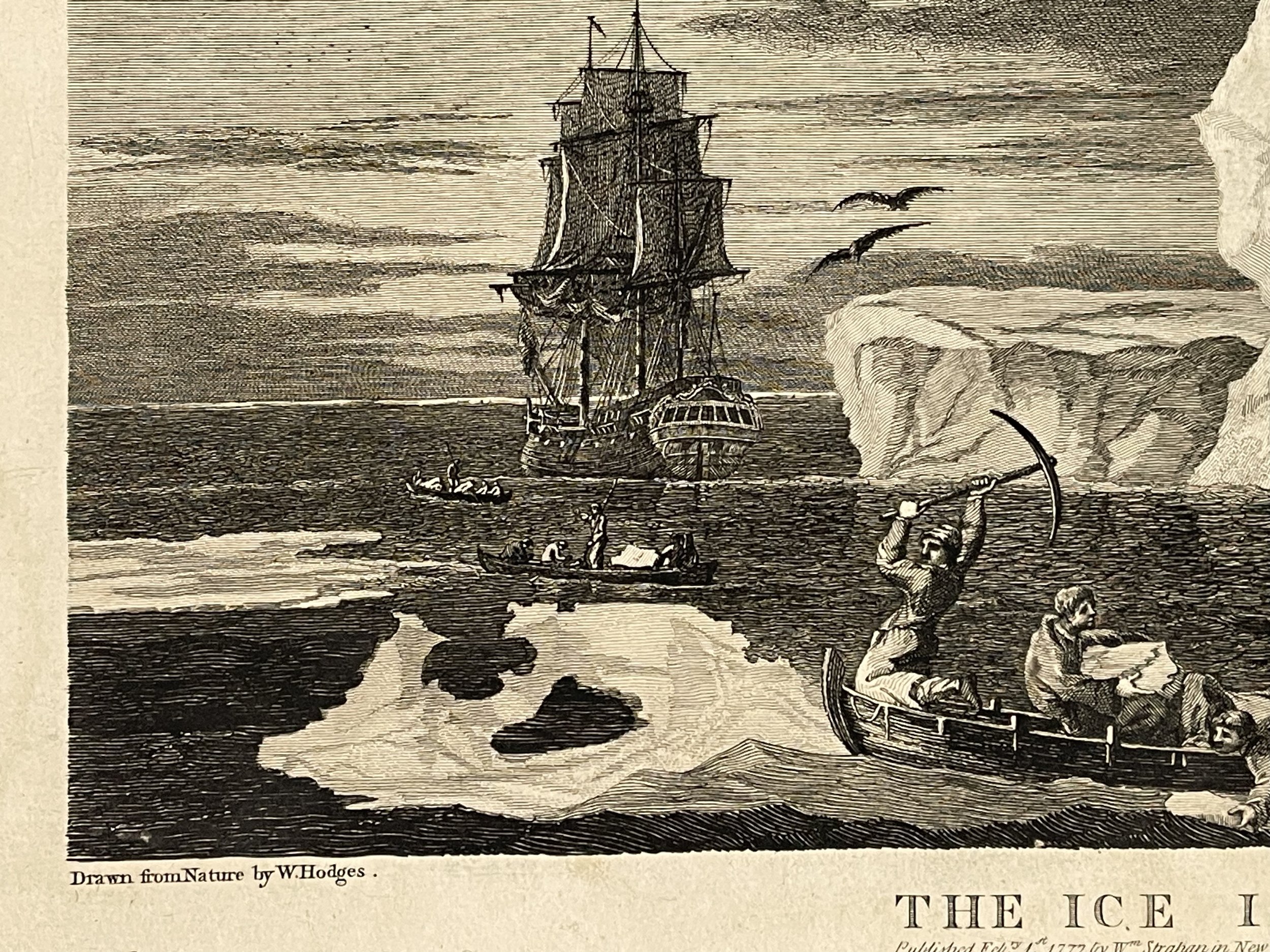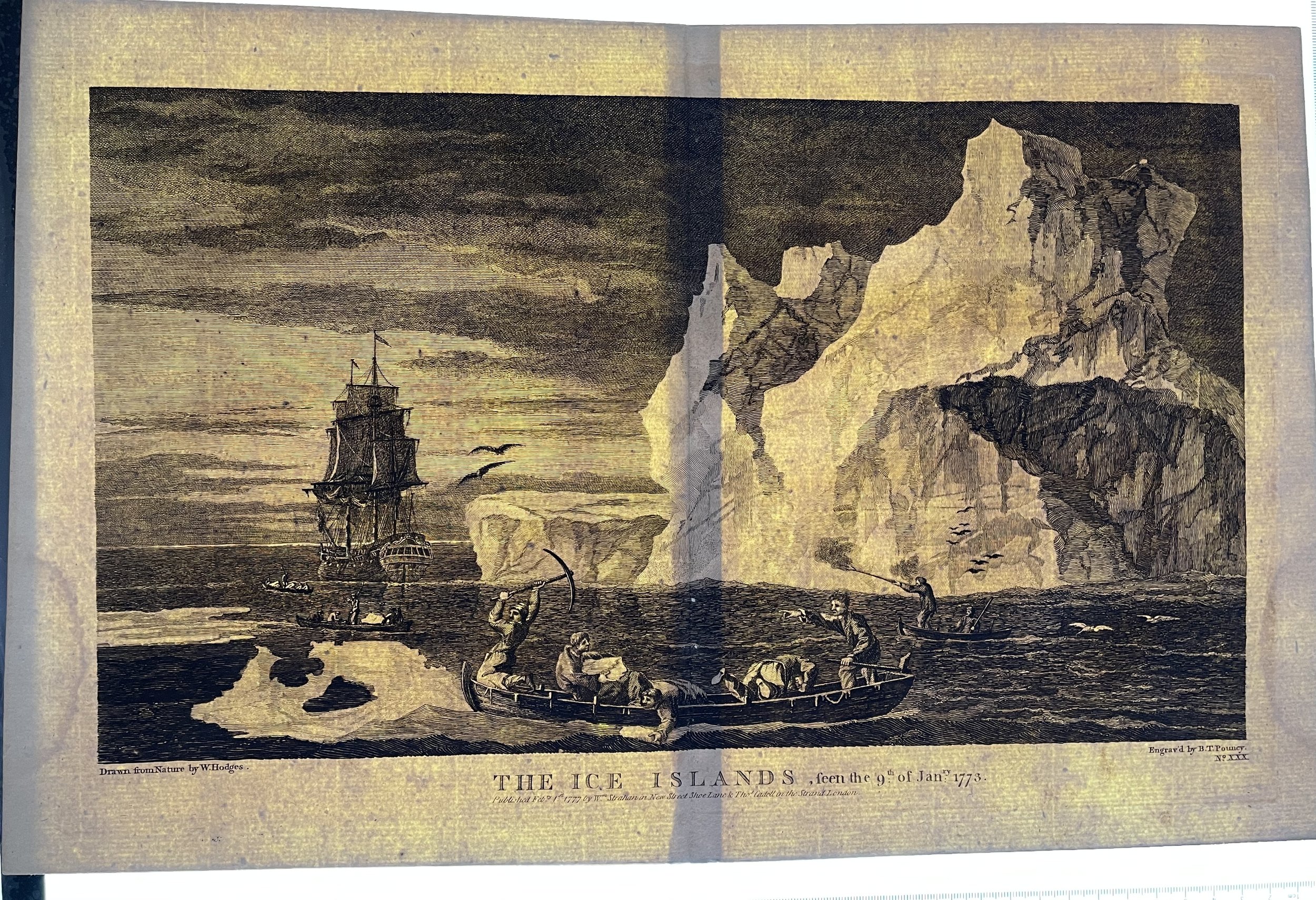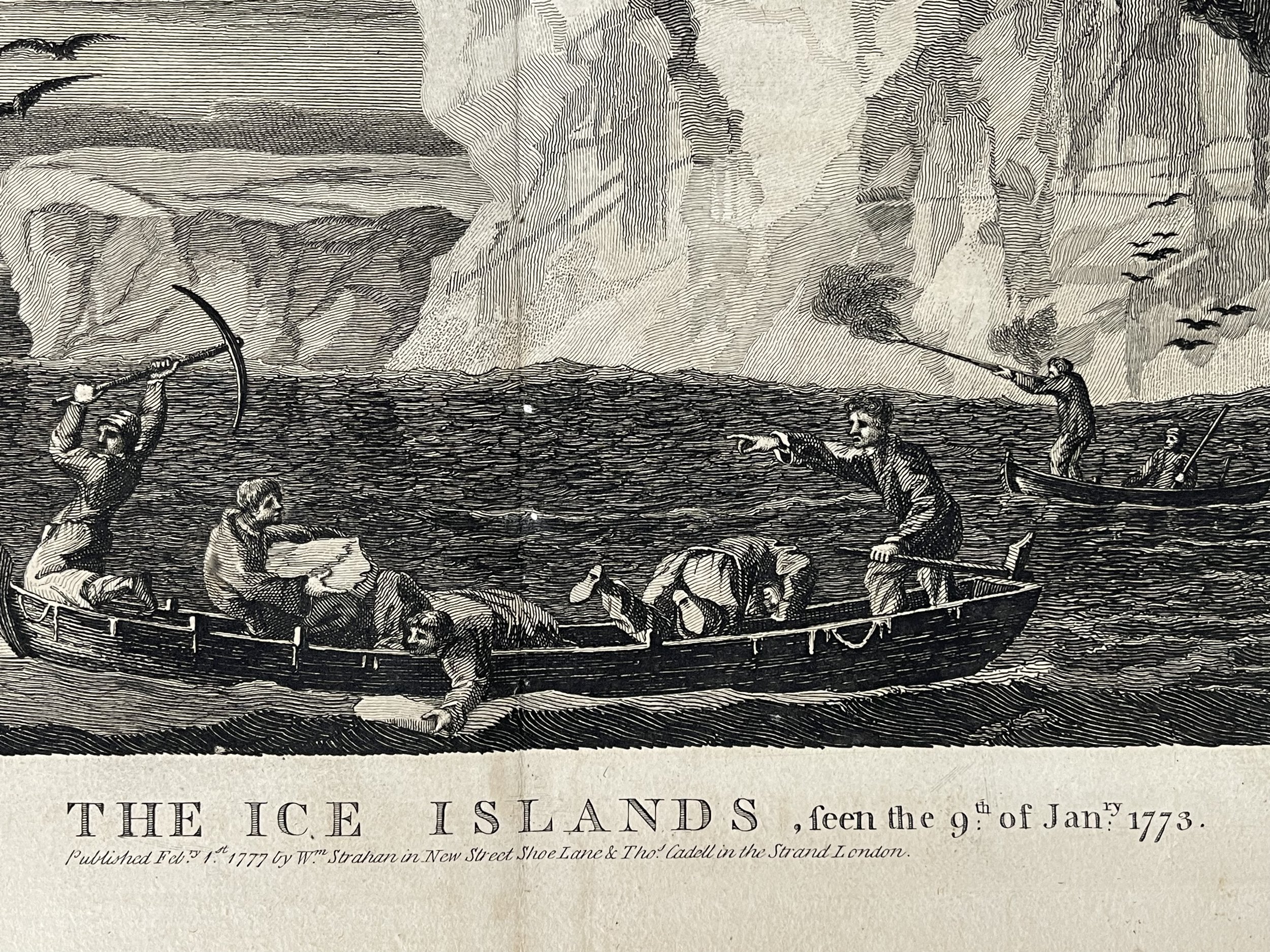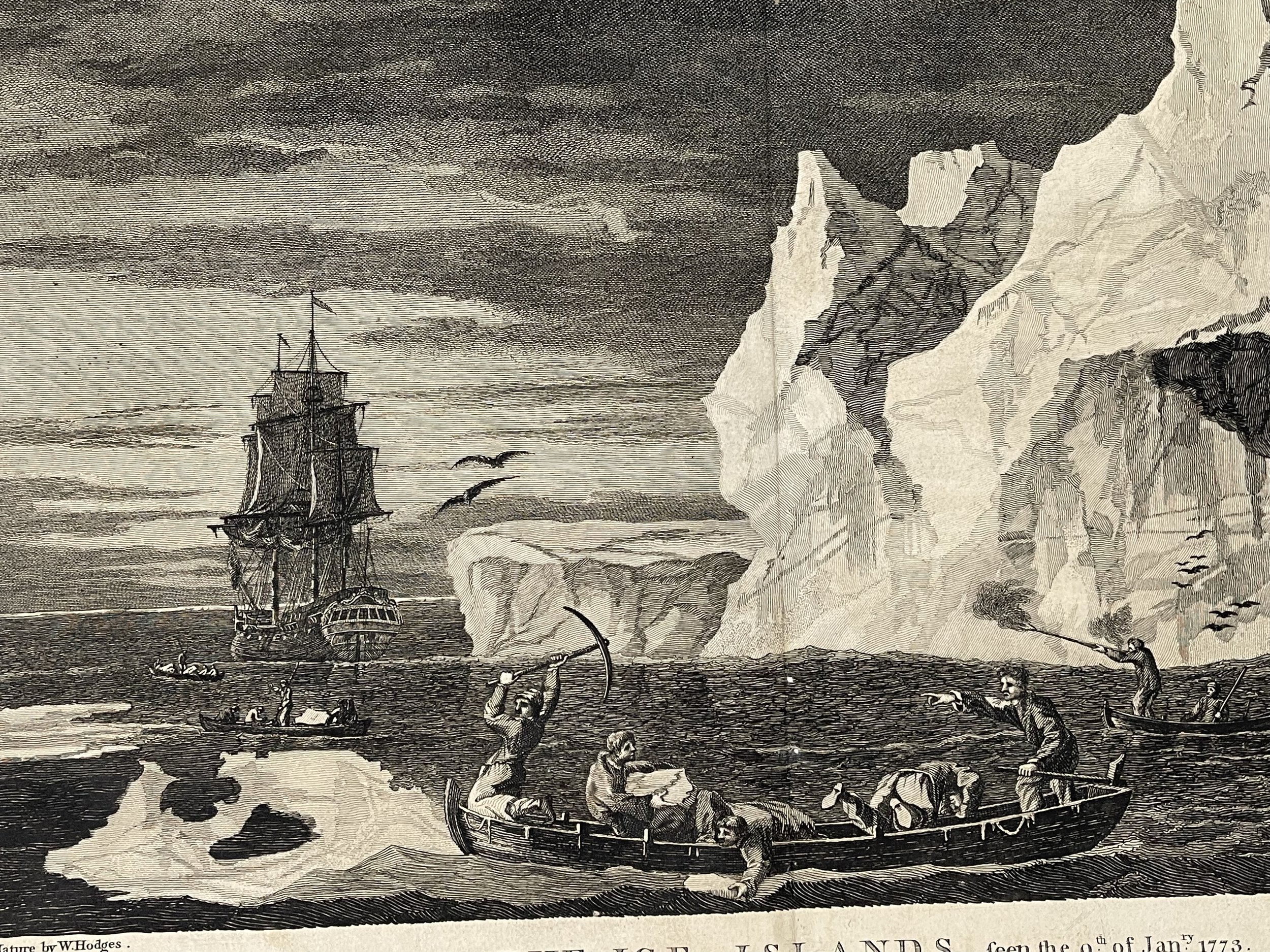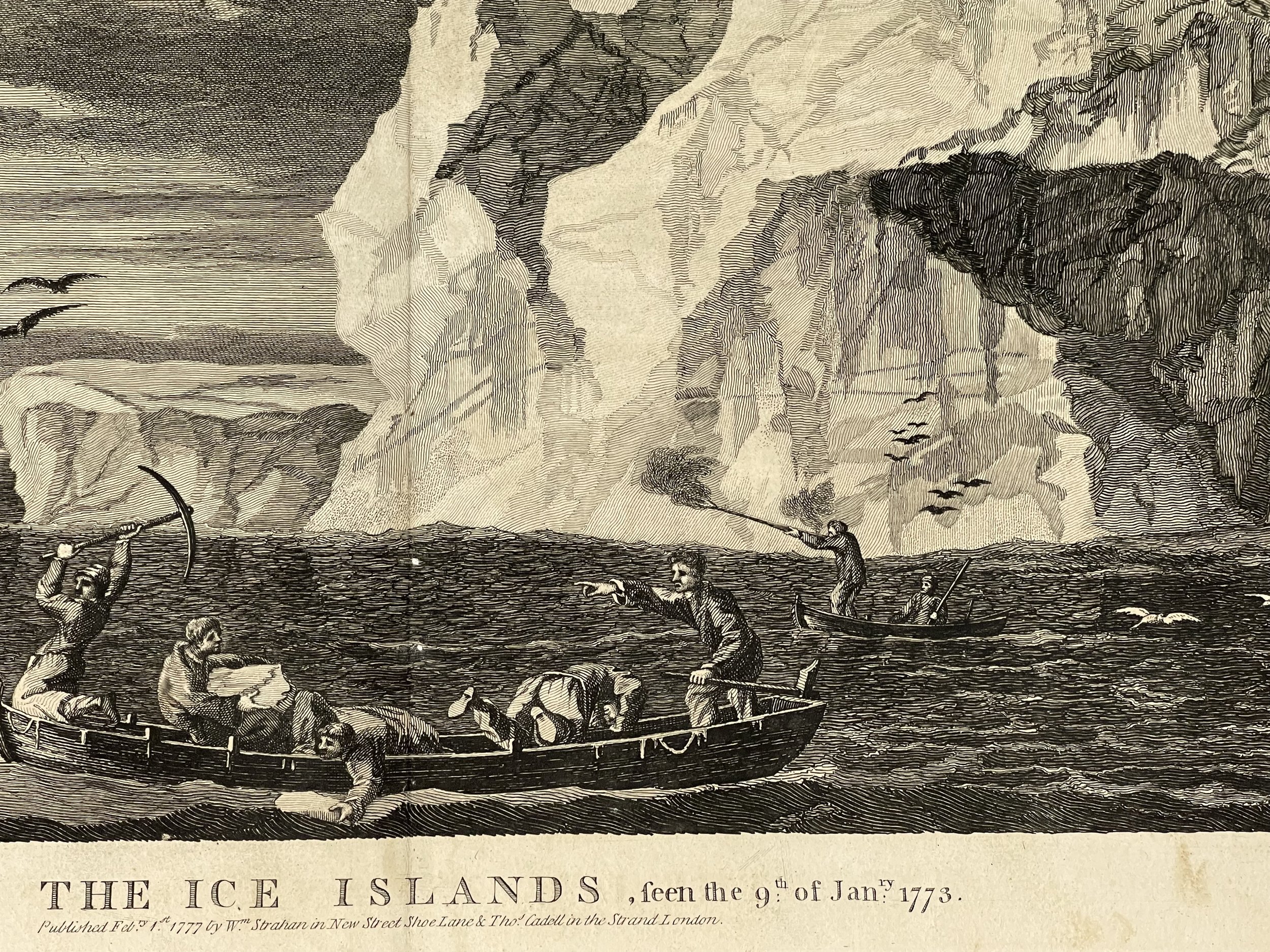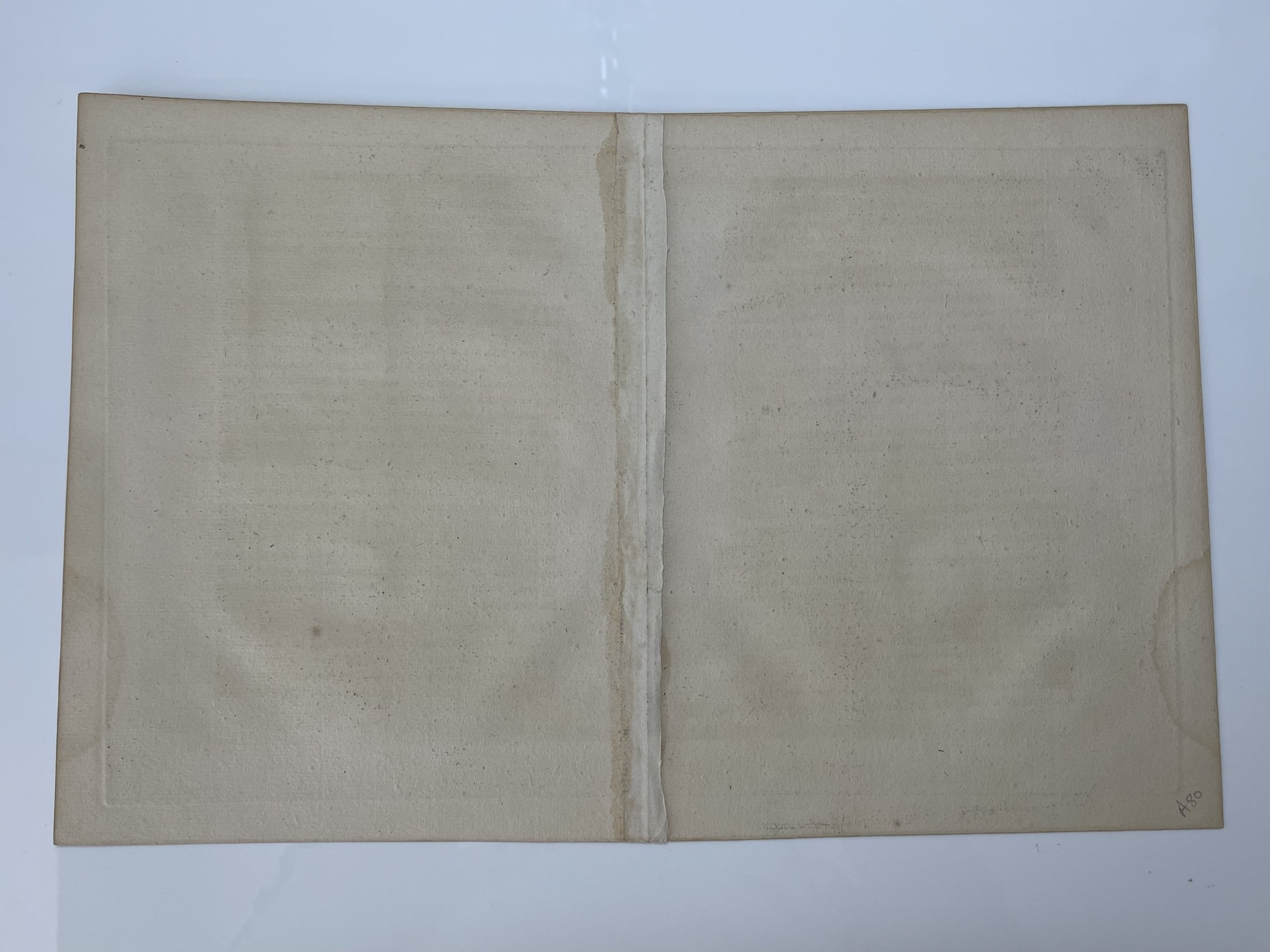The Ice Islands - William Strahn & Thomas Cadell / T. Pourney, W. Hodges - Captain Cook - 1777
The Ice Islands, Seen the 9th of Jan. 1773 (Second Voyage of Captain James Cook, Icebergs, Hunting Seas Birds, Aiming Musket, Age of Exploration) Issued 1777, London, by William Strahn & Thomas Cadell Engraved by T. Pourney, Drawn by W. Hodges.
Thomas Cadell (1742–1802), often referred to as Thomas Cadell the elder, was a successful 18th-century English bookseller who published works by some of the most famous writers of the 18th century.
The business was continued by his son, Thomas Cadell (1773–1836), often referred to as Thomas Cadell the younger, who went into business with William Davies as Cadell & Davies until Davies death in 1819. Cadell continued in business until his own death in 1836.
Fine and uncommon antique print depicting a scene from the voyages of Capt. Cook.
Print remains overall clean & sound. Old prints often display small minor repairs on the back, could have uneven blank margins, might have extraneous fold-lines or other small minor age flaws which do not detract from the visual appeal or value. Pricing and grading commensurate.
Famous engraved view of Cook’s ship and his men breaking ice in Antarctica with their picks on the 9th of January 1773.
Cook had left Cape Town on 22 November 1772 and headed for the area of the South Atlantic where the French navigator Bouvet claimed to have spotted land that he named Cape Circumcision. Shortly after leaving they experienced severe cold weather and early on 23 November 1772 the crew were issued with fearnaught jackets and trousers at the expense of the government. By early December they were sailing in thick fog and seeing ‘ice islands. Cook had not found the island that Bouvet claimed to be in latitude 54°. Pack ice soon surrounded the ships but in the second week in January, in the southern mid-summer, the weather abated, and Cook was able to take the ships southwards through the ice.
Cook records his men getting ice, ‘we hoisted out three Boats and took up as much as yielded about 15 Tons of Fresh Water, the Adventure at the same time got about 8 or 9 and all this was done in 5 or 6 hours’ time; the pieces we took up and which broke from the Main Island, were very hard and solid, some of them too large to be handled so that we were obliged to break them with our Ice Axes before they could be taken into the Boats’, Cook, Journals II, 74.
Cook reached the Antarctic Circle on 17 January. The next day, being severely impeded by the ice, they changed course and headed away to the north-east, after having reached 67°15’s. References; Beddie 1381-33, Joppien 2.6A, ill.p.138, ill. pl.15, p.18 From Cook’s, A Voyage Towards the South Pole, and Round the World, performed in His Majesty’s Ships the ‘Resolution’ and ‘Adventure.’ In the Years 1772, 1773, 1774, and 1775.
The Ice Islands, Seen the 9th of Jan. 1773 (Second Voyage of Captain James Cook, Icebergs, Hunting Seas Birds, Aiming Musket, Age of Exploration) Issued 1777, London, by William Strahn & Thomas Cadell Engraved by T. Pourney, Drawn by W. Hodges.
Thomas Cadell (1742–1802), often referred to as Thomas Cadell the elder, was a successful 18th-century English bookseller who published works by some of the most famous writers of the 18th century.
The business was continued by his son, Thomas Cadell (1773–1836), often referred to as Thomas Cadell the younger, who went into business with William Davies as Cadell & Davies until Davies death in 1819. Cadell continued in business until his own death in 1836.
Fine and uncommon antique print depicting a scene from the voyages of Capt. Cook.
Print remains overall clean & sound. Old prints often display small minor repairs on the back, could have uneven blank margins, might have extraneous fold-lines or other small minor age flaws which do not detract from the visual appeal or value. Pricing and grading commensurate.
Famous engraved view of Cook’s ship and his men breaking ice in Antarctica with their picks on the 9th of January 1773.
Cook had left Cape Town on 22 November 1772 and headed for the area of the South Atlantic where the French navigator Bouvet claimed to have spotted land that he named Cape Circumcision. Shortly after leaving they experienced severe cold weather and early on 23 November 1772 the crew were issued with fearnaught jackets and trousers at the expense of the government. By early December they were sailing in thick fog and seeing ‘ice islands. Cook had not found the island that Bouvet claimed to be in latitude 54°. Pack ice soon surrounded the ships but in the second week in January, in the southern mid-summer, the weather abated, and Cook was able to take the ships southwards through the ice.
Cook records his men getting ice, ‘we hoisted out three Boats and took up as much as yielded about 15 Tons of Fresh Water, the Adventure at the same time got about 8 or 9 and all this was done in 5 or 6 hours’ time; the pieces we took up and which broke from the Main Island, were very hard and solid, some of them too large to be handled so that we were obliged to break them with our Ice Axes before they could be taken into the Boats’, Cook, Journals II, 74.
Cook reached the Antarctic Circle on 17 January. The next day, being severely impeded by the ice, they changed course and headed away to the north-east, after having reached 67°15’s. References; Beddie 1381-33, Joppien 2.6A, ill.p.138, ill. pl.15, p.18 From Cook’s, A Voyage Towards the South Pole, and Round the World, performed in His Majesty’s Ships the ‘Resolution’ and ‘Adventure.’ In the Years 1772, 1773, 1774, and 1775.
The Ice Islands, Seen the 9th of Jan. 1773 (Second Voyage of Captain James Cook, Icebergs, Hunting Seas Birds, Aiming Musket, Age of Exploration) Issued 1777, London, by William Strahn & Thomas Cadell Engraved by T. Pourney, Drawn by W. Hodges.
Thomas Cadell (1742–1802), often referred to as Thomas Cadell the elder, was a successful 18th-century English bookseller who published works by some of the most famous writers of the 18th century.
The business was continued by his son, Thomas Cadell (1773–1836), often referred to as Thomas Cadell the younger, who went into business with William Davies as Cadell & Davies until Davies death in 1819. Cadell continued in business until his own death in 1836.
Fine and uncommon antique print depicting a scene from the voyages of Capt. Cook.
Print remains overall clean & sound. Old prints often display small minor repairs on the back, could have uneven blank margins, might have extraneous fold-lines or other small minor age flaws which do not detract from the visual appeal or value. Pricing and grading commensurate.
Famous engraved view of Cook’s ship and his men breaking ice in Antarctica with their picks on the 9th of January 1773.
Cook had left Cape Town on 22 November 1772 and headed for the area of the South Atlantic where the French navigator Bouvet claimed to have spotted land that he named Cape Circumcision. Shortly after leaving they experienced severe cold weather and early on 23 November 1772 the crew were issued with fearnaught jackets and trousers at the expense of the government. By early December they were sailing in thick fog and seeing ‘ice islands. Cook had not found the island that Bouvet claimed to be in latitude 54°. Pack ice soon surrounded the ships but in the second week in January, in the southern mid-summer, the weather abated, and Cook was able to take the ships southwards through the ice.
Cook records his men getting ice, ‘we hoisted out three Boats and took up as much as yielded about 15 Tons of Fresh Water, the Adventure at the same time got about 8 or 9 and all this was done in 5 or 6 hours’ time; the pieces we took up and which broke from the Main Island, were very hard and solid, some of them too large to be handled so that we were obliged to break them with our Ice Axes before they could be taken into the Boats’, Cook, Journals II, 74.
Cook reached the Antarctic Circle on 17 January. The next day, being severely impeded by the ice, they changed course and headed away to the north-east, after having reached 67°15’s. References; Beddie 1381-33, Joppien 2.6A, ill.p.138, ill. pl.15, p.18 From Cook’s, A Voyage Towards the South Pole, and Round the World, performed in His Majesty’s Ships the ‘Resolution’ and ‘Adventure.’ In the Years 1772, 1773, 1774, and 1775.
Code : A80
Cartographer : Cartographer / Engraver / Publisher: William Strahn & Thomas Cadell / T. Pourney, W. Hodges - Captain Cook
Date : Publication Place / Date - Circa 1777
Size : Sheet size: Image Size: 43.5 x 28 cm
Availability : Available
Type - Genuine - Antique
Grading A
Where Applicable - Folds as issued. Light box photo shows the folio leaf centre margin hinge ‘glue’, this is not visible otherwise.
Tracked postage, in casement. Please contact me for postal quotation outside of the UK.


